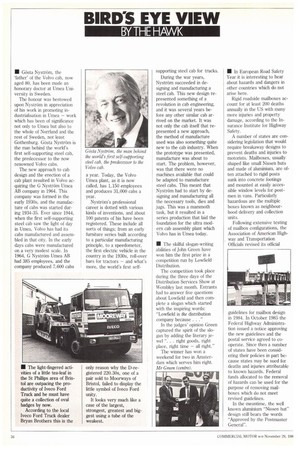BIRDS EYE VIEW
Page 36

If you've noticed an error in this article please click here to report it so we can fix it.
BY THE HAWK
• Gosta Nystrom, the 'father' of the Volvo cab, now aged 80, has been made an honorary doctor at Umea University in Sweden.
The honour was bestowed upon NystrOm in appreciation of his work in promoting industrialisation in Umea — work which has been of significance not only to Umea but also to the whole of NotTland and the rest of Sweden, not least Gothenburg. GOsta Nystrom is the man behind the world's first self-supporting steel cab, the predecessor to the now renowned Volvo cabs.
The new approach to cab design and the erection of a cab plant resulted in Volvo acquiring the G Nystrom Umea AB company in 1964. This company was formed in the early 1930s, and the manufacture of cabs was started during 1934-35. Ever since 1944, when the first self-supporting steel cab saw the light of day in Umea, Volvo has had its cabs manufactured and assembled in that city. In the early days cabs were manufactured on a very modest scale. In 1964, G NystrOm Umea AB had 385 employees, and the company produced 7,600 cabs • The light-fingered activities of a little tea-leaf in the St Phillips area of Bristol are outpacing the productivity of Iveco Ford Truck and he must have quite a collection of oval badges by now.
According to the local Iveco Ford Truck dealer Bryan Brothers this is the a year. Today, the Volvo Umea plant, as it is now called, has 1,150 employees and produces 31,000 cabs a year.
Nystrom's professional career is dotted with various kinds of inventions, and about 100 patents of his have been registered. These include all sorts of things; from an early furniture series built according to a particular manufacturing principle, to a speedometer, the first electric vehicle in the country in the 1930s, roll-over bars for tractors — and what's more, the world's first self only reason why the D-registered 220.30s, one of a pair sold to Moorways of Bristol, failed to display the little symbol of Iveco Ford unity.
It looks very much like a case of the largest, strongest, greatest and biggest using a tube of the weakest. supporting steel cab for trucks.
During the war years, NystrOm succeeded in designing and manufacturing a steel cab. This new design represented something of a revolution in cab engineering, and it was several years before any other similar cab arrived on the market. It was not only the cab itself that represented a new approach, the method of manufacture used was also something quite new to the cab industry. When the prototype was presented, manufacture was about to start. The problem, however, was that there were no machines available that could be adapted to manufacture steel cabs. This meant that NystrOm had to start by designing and manufacturing all the necessary tools, dies and jugs. This was a mammoth task, but it resulted in a series production that laid the foundation for the ultra modern cab assembly plant which Volvo has in Umea today.
• The skilful slogan-writing abilities of John Green have won him the first prize in a competition run by Lowfield Distribution.
The competition took place during the three days of the Distribution Services Show at Wembley last month. Entrants had to answer five questions about Lowfield and then complete a slogan which started with the inspiring words: "Lowfield is the distribution company because . . ."
In the judges' opinion Green captured the spirit of the slogan by adding the literary jewel ". , right goods, right place, right time — all right."
The winner has won a weekend for two in Amsterdam which serves him right. Mr Green (centre). • In European Road Safety Year it is interesting to hear about hazards and dangers in other countries which do not arise here.
Rigid roadside mailboxes account for at least 200 deaths annually in the US with many more injuries and property damage, according to the Insurance Institute for Highway Safety.
A number of states are considering legislation that would require breakaway designs to prevent deaths and injuries to motorists. Mailboxes, usually shaped like small Nissen huts and made of aluminium, are often attached to rigid posts sunk into concrete footings and mounted at easily accessible window levels for postmen in vans. Particularly hazardous are the multiple boxes known as neighbourhood delivery and collection units.
Following extensive testing of mailbox configurations, the Association of American Highway and Transportation Officials revised its official guidelines for mailbox design in 1984. In October 1985 the Federal Highway Administration issued a notice approving the new guidelines and the postal service agreed to cooperate. Since then a number of states have been considering their policies in part because states may be sued for deaths and injuries attributable to known hazards. Federal funds allocated to the removal of hazards can be used for the purpose of removing mailboxes which do not meet revised guidelines.
In the meantime, the well known aluminium "Nissen hut" design still bears the words "Approved by the Postmaster General".
























































































































